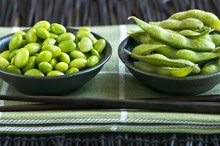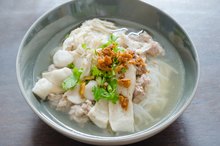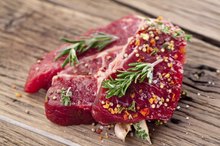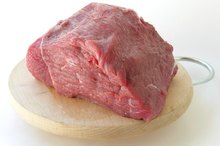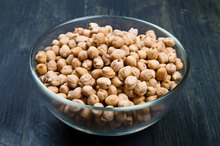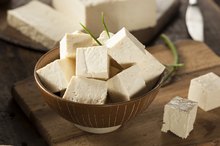List of Complete Protein Foods
Protein is a nutrient essential for life. As an energy-yielding macronutrient, it is required daily in larger quantities than vitamins and minerals. Functions of protein include forming cells as well as the structure of body tissues and muscles. Amino acids, the building blocks of protein, are used for manufacturing some hormones, enzymes and all antibodies. Many foods offer some protein; however, "complete" protein foods provide all nine essential amino acids, which are those you must obtain through dietary sources.
Meat, Poultry and Fish
Animal foods, such as red meat, pork, game meats, poultry and fish, all are complete protein foods. Examples of specific cuts and types of red meats include ground round or sirloin, eye of round steak and beef tenderloin. Many game meats, such as bison or buffalo and venison, are leaner than cattle but still contain the same amount of high-quality protein, ounce for ounce, as beef. Examples of pork products that are complete protein foods include center-cut pork chops, pork tenderloin and ham. All varieties of poultry are complete protein food sources, including chicken thighs, legs or breasts and turkey or duck breast. Fish and shellfish are lean complete protein foods that are particularly rich in essential minerals. Examples include shrimp, scallops, clams, tuna, salmon, halibut, whitefish, cod and swordfish. According to MayoClinic.com, 1 ounce of red meat, pork, poultry or fish provides 7 grams of protein.
- Animal foods, such as red meat, pork, game meats, poultry and fish, all are complete protein foods.
- Examples of pork products that are complete protein foods include center-cut pork chops, pork tenderloin and ham.
Eggs and Dairy Products
Protein Content of Canned Salmon
Learn More
Eggs and dairy products are also animal-derived complete protein sources that provide all nine essential amino acids. Eggs are protein-rich, but most of the protein is in the egg white. One egg, depending upon size, provides 6 to 7 grams of protein. According to MayoClinic.com, cheese, milk and yogurt are complete protein foods, and 1 ounce of Swiss, American, bleu, Brie, hard goat, Cheddar or Monterey Jack cheese provides 7 grams of protein. CommonSenseHealth.com reports that 1 cup of milk provides 8 grams of protein, an 8-ounce cup of yogurt has 10 to 13 grams of protein and 1/2-cup of low-fat cottage cheese has 14 to 16 grams of protein.
- Eggs and dairy products are also animal-derived complete protein sources that provide all nine essential amino acids.
- One egg, depending upon size, provides 6 to 7 grams of protein.
Vegan Foods
Fortunately, for individuals who follow a vegan diet, there are plant-based foods that are complete protein choices, including soy products and quinoa, a protein-rich whole grain. Soybeans form the basis of many processed soy foods, all of which are complete protein sources, such as soy milk, tempeh, tofu, miso and edamame, or fresh green soybeans. According to the The World's Healthiest Foods, a 1/2-cup serving of cooked soybeans provides 14 grams of protein and 4 ounces or a 1/2-cup of fresh tofu provides 9 to 10 grams of protein. Soy protein isolate is a highly refined form of soy protein in which most of the carbohydrates have been removed. It may be used as a protein supplement in powdered form. According to the Soy Foods Association of North America, one scoop or 1 ounce of powdered soy protein isolate provides 20 to 23 grams of protein. Quinoa, a whole grain with edible seeds, is another vegan-friendly complete protein food -- each cup of cooked uqinoa provides 9 grams of protein.
- Fortunately, for individuals who follow a vegan diet, there are plant-based foods that are complete protein choices, including soy products and quinoa, a protein-rich whole grain.
Related Articles
References
- MayoClinic.com: Exchange Lists -- Meat and Meat Substitutes
- World's Healthiest Foods: Soybeans
- Rodríguez L, Cervantes E, Ortiz R. Malnutrition and gastrointestinal and respiratory infections in children: a public health problem. Int J Environ Res Public Health. 2011;8(4):1174-205. doi:10.3390/ijerph8041174
- Leidy HJ, Clifton PM, Astrup A, et al. The role of protein in weight loss and maintenance. Am J Clin Nutr. 2015;101(6):1320S-1329S. doi:10.3945/ajcn.114.084038
- Leidy HJ, Armstrong CLH, Tang M, Mattes RD, Campbell WW. The influence of higher protein intake and greater eating frequency on appetite control in overweight and obese men. Obesity. 2010;18(9):1725-1732. doi:10.1038/oby.2010.45
- Harris WS. Omega-3 fatty acids. In: Coates PM, Betz JM, Blackman MR, et al., eds. Encyclopedia of Dietary Supplements. 2nd ed. London and New York: Informa Healthcare; 2010:577-86.
- U.S. Food and Drug Administration. Advice About Eating Fish. Updated July 2019.
- de Gavelle E, Huneau J-F, Bianchi CM, Verger EO, Mariotti F. Protein adequacy Is primarily a matter of protein quantity, not quality: Modeling an increase in plant:animal protein ratio in French adults. Nutrients. 2017;9(12). doi:10.3390/nu9121333
- FoodData Central. U.S. Department of Agriculture. Published April 1, 2020.
- U.S. National Library of Medicine. What are proteins and what do they do?.
- US Department of Agriculture. All about the protein foods group.
Resources
Writer Bio
Michele Turcotte is a registered, licensed dietitian, and a certified personal trainer with the National Academy of Sports Medicine. She has more than 12 years of experience in clinical and corporate settings, and has extensive experience in one-on-one diet counseling and meal planning. She has written freelance food and nutrition articles for Trouve Publishing Inc. since 2004.

